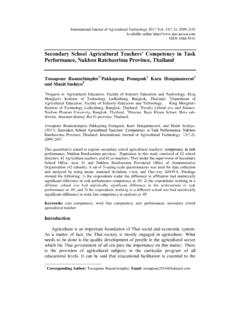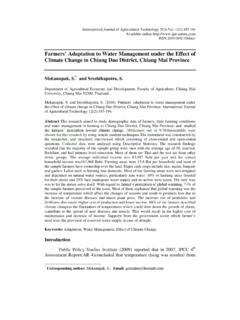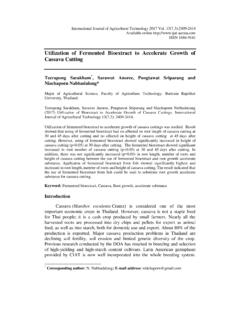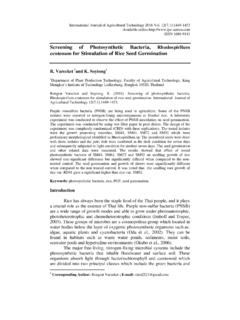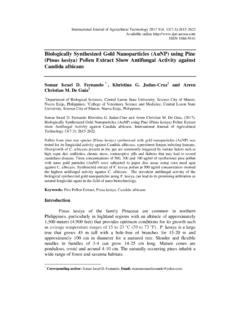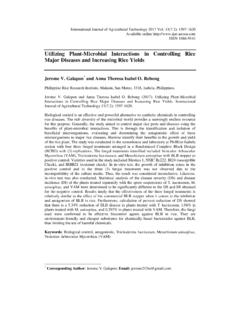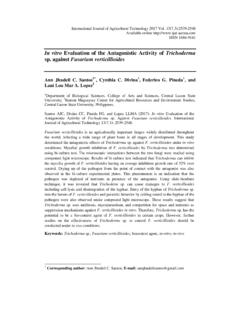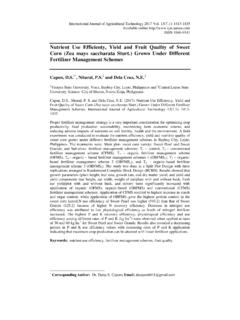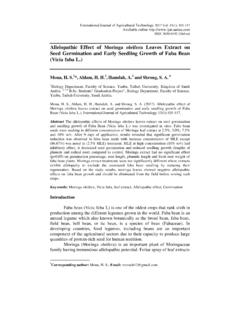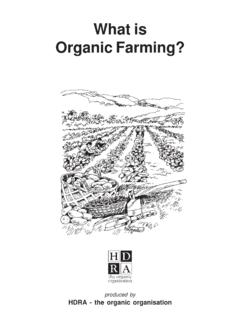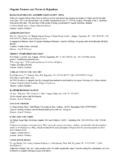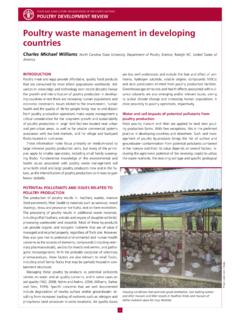Transcription of Efficiency of Trichoderma spp. from Carabao Manure as ...
1 International Journal of Agricultural Technology 2017 Vol. 13(5): 683-697 Available online ISSN 2630-0192 (Online) Efficiency of Trichoderma spp. from Carabao Manure as Compost Activator and Utilization of Organic Fertilizer Produced in Pechay and Lettuce Production Galindez, J. L., Porciuncula, F. L.*, Lopez, L. L. M. A., Pascua, M. P., Romero, E. S. and Juico, P. P. Ramon Magsaysay Center for Agricultural Resources and Environment Studies(RM-CARES), Central Luzon State University, Science City of Munoz, Nueva Ecija, Philippines. Galindez, J. L., Porciuncula, F. L., Lopez, L. L. M. A., Pascua, M. P., Romero, E. S. and Juico, P. P. (2017). Efficiency of Trichoderma spp. from Carabao Manure as compost activator and utilization of organic fertilizer produced in pechay and lettuce production. International Journal of Agricultural Technology 13(5):683-697. Abstract Trichoderma spp. are naturally occurring fungus with ability to enhance decomposition.
2 Efficiency of Trichoderma spp. as compost activator was evaluated using the following: T1-rice straw (RS) + Carabao Manure (CM); T2 RS (75%) + ipil-ipil leaves (25%) + CM + CRH + 2 kg Trichoderma spp. per ton of compost pile applied during piling; T3 RS (75%) + ipil-ipil leaves (25%) + CM + CRH + 2 kg Trichoderma spp. per ton of compost pile applied during piling (1 kg) and during first turning (1 kg); T4 RS (75%) + ipil-ipil leaves (25%) + CM + CRH + 1 kg Trichoderma spp. applied during piling and 1 kg during first and second turning; T5-RS (75%) + ipil-ipil leaves (25%) + CM + CRH + 1 kg Trichoderma spp. applied during piling and 1 kg during first and second turning + actinomycetes on the last turning; T6- RS (75%) + ipil-ipil leaves (25%) + CM + commercial compost activator. In the first experiment, the compost pile applied with Trichoderma spp. regardless of frequency of application did not differ on the number of days to harvest (74), while the control took 102 days to harvest.
3 Percent recovery was high on Treatment 2 at The composite nutrient content of the compost has organic matter; nitrogen; phosphorus; and potassium. To improve the nutrient content of the compost, another experiment was set-up with increased percentage (30%) of greens composed of ipil-ipil leaves, kakawate and banana bracts. Treatment 2 again recorded the highest percent recovery ( ), with days to harvest at 69. Treatment 5 has the highest NPK content of with similar 69 days decomposition period. Increasing the rate of Trichoderma spp. was also evaluated and results showed shortened days to harvest at 66, with split application (during piling, and first and second turning) of 6 kg Trichoderma per ton of compost pile. Pechay and lettuce applied with the produced organic fertilizer from T5, significantly obtained higher yield ( and t/ha, respectively), compared to plants applied with commercial organic fertilizer.
4 Keywords: Trichoderma spp., compost activator, organic fertilizer, decomposition period, percent recovery *Corresponding author: Porciuncula, F. L.; Email: 684 Introduction The potential of composting to turn on- farm waste materials into a farm resource makes it an attractive proposition. composting offers several benefits such as enhanced soil fertility and soil health, thereby contributing to increased agricultural productivity, improved soil biodiversity, reduced ecological risks and a sound environment. While traditional composting procedures take as long as 4-8 months to produce compost, rapid composting methods using fungus to hasten decomposition period offer possibilities of reducing the processing period up to three months, which is a great advantage over the conventional method of composting . Trichoderma spp. is a type of fungus that can be isolated from animal Manure (Aganon, et al.)
5 , 2008; Lopez, et al., 2014). It is very easy to grow and can be mass produced under laboratory condition. Aside from being a bio-control agent against other organisms, Trichoderma spp. also helps as a decomposer for biodegradable materials. As such, the effectiveness of Trichoderma spp. as decomposer and the quality of organic fertilizer produced from this experiment is the subject of this research. Objectives: The study was conducted to determine the Efficiency of Trichoderma spp. as decomposer for biodegradable materials. Specifically, the study aims to: a) establish the amount of Trichoderma spp. to hasten decomposition period; b) determine the quality of organic fertilizer applied with Trichoderma spp.; and c) evaluate the efficacy of organic fertilizer produced in pechay and lettuce production. Materials and method Experimental set-up in the Use of Trichoderma spp. Isolated from Carabao Manure as Compost Activator Experiment in determining the efficacy of Trichoderma spp.
6 Isolated from Carabao Manure as compost activator was established using the different treatments with the ratio of 3:1:1. The following treatments were evaluated: T1 rice straw + Carabao Manure T2 rice straw (75%) + ipil-ipil leaves (25%) + Carabao Manure + CRH + 2 kg Trichoderma spp. applied during piling T3 RS (75%) + ipil-ipil leaves (25%) + CM + CRH + 2 kg Trichoderma spp. per ton of compost pile applied during piling (1 kg) and during first turning (1 kg) International Journal of Agricultural Technology 2017 Vol. 13(5): 683-697 685 T4 RS (75%) + ipil-ipil leaves (25%) + CM + CRH + 1 kg Trichoderma spp. applied during piling and 1 kg during first and second turning T5-RS (75%) + ipil-ipil leaves (25%) + CM + CRH + 1 kg Trichoderma spp. applied during piling and 1 kg during first and second turning + actinomycetes on the last turning T6-rice straw (75%) + ipil-ipil leaves (25%) + Carabao Manure + commercial compost activator Collection of biodegradable wastes such as leaf litters, rice straw, Carabao Manure , green leaves (ipil-ipil), carbonized rice hull were done before piling of the different compost treatments.
7 The ratio and proportion of each material were indicated in the treatments. The amount of Trichoderma spp. was added based on the scheduled application at 2 kg per ton of compost. The compost piles with the size of 1m width x 2m length x 2m height were established at the RM-CARES Material Recovery Facility. The set-up was monitored from the start to maturity of each pile. Days of composting period was recorded and the quality of the compost was also determined. Compost piles were turned or mixed every two weeks to make sure that the compost materials and the Trichoderma spp. were well distributed and to check whether the compost pile still have enough moisture to undergo faster decomposition. Turning was done every two weeks until the compost pile were fully decomposed and ready for harvesting. Harvesting of the compost was done when the materials were no longer recognizable, with stable temperature and the compost becomes dark in color.
8 Experimental Design The experiment was laid out following the Randomized Complete Block Design (RCBD) with three replications for each treatment. Data Gathered The data gathered were days to maturity/harvest, temperature, percent recovery and nutrient content of compost in terms nitrogen, potassium and phosphorous (NPK). Data Analysis Data gathered were analyzed using Randomized Complete Block Design (RCBD). Comparison among means was done using Duncan s Multiple Range Test (DMRT). 686 Experimental Set-up Re Application of Trichoderma spp. with Additional Greens in the Raw Materials To increase nutrient content of the produced organic fertilizer particularly NPK, the following treatment combinations, zeroing on the addition of kakawate leaves and banana bracts apart from ipil-ipil and increasing the ratio at 30%, were established and evaluated: T1- rice straw+ Carabao Manure ; T2- rice straw (70%) + ipil-ipil leaves + kakawate leaves + banana bracts (30%) + Carabao Manure + CRH + 2 kg Trichoderma spp.
9 Per ton of compost pile applied during piling; T3-rice straw (70%) + ipil-ipil leaves + kakawate leaves + banana bracts (30%) + Carabao Manure + CRH + 2 kg Trichoderma spp. per ton of compost pile applied during piling (1 kg) and during first turning (1 kg) of compost pile; T4-rice straw (70%) + ipil-ipil leaves+ kakawate leaves + banana bracts (30%) + Carabao Manure + CRH + 1 kg Trichoderma spp. applied during piling and 1 kg during first and second turning of compost pile; T5-rice straw (70%) + ipil-ipil leaves+ kakawate leaves + banana bracts (30%)+ Carabao Manure + CRH + 1 kg Trichoderma spp. applied during piling and 1 kg during first and second turning of compost pile + actinomycetes on the last turning of pile; T6-rice straw (70%) + ipil-ipil leaves+ kakawate leaves + banana bracts (30%) + Carabao Manure +commercial compost activator. Collection of biodegradable wastes needed for the establishment of the expereimental set-up such as leaf litters, rice straw, Carabao Manure , green leaves (ipil-ipil, kakawate, banana bracks), carbonized rice hull were done before piling of the different compost treatments.
10 The ratio and proportion of each material were indicated in the treatments. The recommended amount of Trichoderma spp. per ton of biodegradable wastes was added based on the scheduled application. The compost piles with the size of 1m width x 2m length x 2m height were established at the RM-CARES Material Recovery Facility. The set-up was monitored from the start to maturity of each pile. Days to harvest were recorded and the quality of the compost was also determined. Compost piles were turned or mixed every two weeks to make sure that the compost materials and the Trichoderma spp. were well distributed and to check whether the compost pile still have enough moisture to undergo faster International Journal of Agricultural Technology 2017 Vol. 13(5): 683-697 687 decomposition. Turning was done every two weeks until the compost pile was fully decomposed and ready for harvesting. Harvesting of the compost was done when the materials were no longer recognizable, with stable temperature and the compost becomes dark in color.
